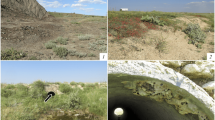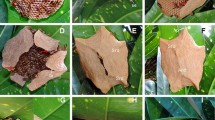Summary
Observations on the nesting activities ofMicrothurge corumbae, carried out at the University Campus of Ribeirão Preto, São Paulo, Brazil, from 1977 to 1981, indicated that 61.9 % of nests were re-used by succeeding generations. Re-use by one generation was more frequent than by two generations, and re-use by a third was observed only once. Nests were re-used by one or several females. Single females were more frequently in the first re-use. In these cases nest re-use did not differ essentially from the solitary foundation of a new nest, except for the adoption of a pre-existing nest without excavation. In multifemale nests, analysis of relative age (wing wear), ovarian and spermathecal conditions of associated females and the content of nests at excavation indicated that the social pattern in such colonies is communal. There is some evidence that the associated females are relatives. The chalcidoid waspLeucospis was the principal nest parasite, and ants of the genusCrematogaster were nest predators. In multifemale nests, the rate of parasitism was significantly lower than in solitary nests, indicating that nest-sharing resulted in improved nest defense. On the other hand, the absence of predation on immatures of the first generation of M.commbae in multifemale nests suggests that such nests are also more resistant to attack by predators.
Similar content being viewed by others
References
Abrams, J. and G. C. Eickwort, 1980. Biology of the communal sweat beeAgapostemon virescens (Hymenoptera: Halictidae) in New York State.Search (Cornell Univ. Agr. Exp. Sta) 1, 20.
Abrams, J. and G. C. Eickwort, 1981. Nest switching and guarding by the communal sweat beeAgapostemon virescens (Hymenoptera, Halictidae).Ins. Soc. 28:105–116.
Alcock, J., 1980. Communal nesting in an Australian solitary wasp,Cerceris antipodes Smith (Hymenoptera, Sphecidae).J. Aust. Entomol. Soc. 19:223–228.
Bohart, G. E., and N. N. Youssef, 1976. The biology and behavior ofEvylaeus galpinsiae Cockerell (Hymenoptera: Halictidae).Wasmann J. Biol. 34:185–234.
Camillo, E., and C. A. Garófalo, 1989. Social organization in reactivated nests of three species ofXylocopa (Hymenoptera, Anthophoridae) in southeastern Brazil.Ins. Soc. 36:92–105.
Camillo, E., C. A. Garófalo, M. J. O. Campos and J. C. Serrano, 1983. Preliminary notes on the biology ofLithurgus huberi (Hymenoptera, Megachilidae).Rev. Bras. Biol. 43:151–156.
Claude-Joseph, F., 1926. Recherches biologiques sur les Hyménoptéres du Chili (Melliféres).Ann. Sci. Nat. (Zool.) Paris, Ser. 10, 9:113–268.
Cros, A., 1939. Considerations generales sur le genreLithurgus Latr. et biologie duLithurgus tibialis Mor. (Hymenoptera, Apidae, Megachilidae).Bull. Soc. Fouad Ier Ent. Cairo 23:37–59.
Danforth, B. N., 1989. Nesting behavior of four species ofPerdita (Hymenoptera: Andrenidae).J. Kansas Entomol. Soc. 62:59–79.
Elliott, N. B., T. Shlotzhauer and W. M. Elliott, 1986. Nest use by females of the presocial waspCerceris watlingensis (Hymenoptera: Sphecidae).Ann. Entomol. Soc. Am. 79:994–998.
Evans, H. E., and A. W. Hook, 1982. Communal nesting in the digger waspCerceris australis (Hymenoptera: Sphecidae).Aust. J. Zool. 30:557–568.
Evans, H. E., and A. W. Hook, 1986. Nesting behavior of AustralianCerceris digger wasps, with special reference to nest reutilization and nest sharing (Hymenoptera, Sphecidae).Sociobiology 11:275–302.
Garófalo, C. A., E. Camillo, M. J. O. Campos, R. Zucchi and J. C. Serrano, 1981. Bionomical aspects ofLithurgus corumbae (Hymenoptera, Megachilidae), including evolutionary considerations on the nesting behavior of the genus.Rev. Brasil. Gent. 4:165–182.
Hook, A. W., 1987. Nesting behavior of TexasCerceris digger wasps with emphasis on nest reutilization and nest sharing (Hymenoptera: Sphecidae).Sociobiology 13:93–118.
Houston, T. F., 1971. Notes on the biology of a lithurgine bee (Hymenoptera, Megachilidae) in Queensland.J. Aust. Ent. Soc. 10:31–36.
Krombein, K. V., 1967.Trap-nesting wasps and bees: life histories, nests and associates. Smithsonian Press, Washington, D.C., 570 pp.
Lin, N., 1964. Increased parasitic pressure as a major factor in the evolution of social behavior in halictine bees.Ins. Soc. 77:187–192.
Lin, N., and C. D. Michener, 1972. Evolution of sociality in insects.Q. Rev. Biol. 47:131–159.
Malishev, S. J., 1930. Nistgewohnheiten der Steinbienen,Lithurgus Latr. (Apoidea).Zeitschr. Morph. Okol. Tiere 19:116–134.
McCorquodale, D. B., 1988. Relatedness among nestmates in a primitively social wasp,Cerceris antipodes (Hymenoptera: Sphecidae).Behav. Ecol. Sociobiol. 23:401–406.
McCorquodale, D. B., 1989. Nest defense in single and multifemale nests ofCerceris antipodes (Hymenoptera: Sphecidae).J. Insect Behav. 2:267–276.
Mello, M. L. S., and C. A. Garófalo, 1986. Structural dimorphism in the cocoons of a solitary beeLithurgus corumbae (Hymenoptera: Megachilidae) and its adaptative significance.Zool. Anz. 277:195–206.
Michener, C. D., 1958. The evolution of social behavior in bees.Proc. Tenth International Congress of Entomology, Montreal,2, p. 441–447.
Michener, C. D., 1974.The social behavior of the bees. A comparative study. The Belknap Press of Harvard University Press, Cambridge, Mass., 404 pp.
Michener, C. D., 1983. The classification of the Lithurginae.Pan-Pac. Entomol. 59:176–187.
Michener, C. D., and R. B. Lange, 1958a. Observations on the behavior of Brazilian halictid bees (Hymenoptera, Apoidea). I.Pseudagapostemon.Ann. Ent. Soc. Amer. 57:155–164.
Michener, C. D., and R. B. Lange, 1958b. Observations on the behavior of Brazilian halictid bees. V.Chloralictus. Ins. Soc. 5:379–407.
Parker, F. D., and H. W. Potter, 1973. Biological notes onLithurgus apicalis Cresson (Hymenoptera: Megachilidae).Pan-Pac. Entomol. 49:294–299.
Pereira-Martins, S. R., 1991. Biologia deEulaema nigrita. 2. Atividades nidais.Papéis Avulsos Zool.,S. Paulo 37:237–243.
Roberts, R. B., 1978. The nesting biology, behavior and immature stages ofLithurgus chrysurus an adventitious wood-boring bee in New Jersey (Hymenoptera, Megachilidae).J. Kansas Entomol. Soc. 51:735–745.
Rozen, J. G., 1973. Immature stages of lithurgine bees with descriptions of the Megachilidae and Fideliidae based on mature larvae (Hymenoptera, Apoidea).Amer. Mus. Novitates 2527:1–14.
Sakagami, S. F., and R. Zucchi, 1978. Nests ofHylaeus (Hylaeopsis)tricolor: the first record of nonsolitary life in collectid bees, with notes on communal and quasisocial colonies (Hymenoptera: Colletidae).J. Kansas Entomol. Soc. 57:597–614.
Schwarz, M. P., 1986. Persistent multi-female nests in an Australian allodapine bee,Exoneura bicolor (Hymenoptera, Anthophoridae).Ins. Soc. 33:258–277.
Snelling, R. R., 1983. The North American species of the genusLithurge (Hymenoptera, Megachilidae).Contrib. Sci., Nat. Hist. Mus., Los Angeles Co. 343:11 pp.
Zucchi, R., S. F. Sakagami and J. M. F. Camargo, 1969. Biological observations on a neotropical parasocial bee,Eulaema nigrita, with a review on the biology of Euglossinae (Hymenoptera, Apidae). A comparative study.J. Fac. Sci., Hokkaido Univ. VI, Zool. 17:271–380.
Author information
Authors and Affiliations
Rights and permissions
About this article
Cite this article
Garófalo, C.A., Camillo, E., Campos, M.J.O. et al. Nest re-use and communal nesting inMicrothurge corumbae (Hymenoptera, Megachilidae), with special reference to nest defense. Ins. Soc 39, 301–311 (1992). https://doi.org/10.1007/BF01323950
Received:
Revised:
Accepted:
Issue Date:
DOI: https://doi.org/10.1007/BF01323950




